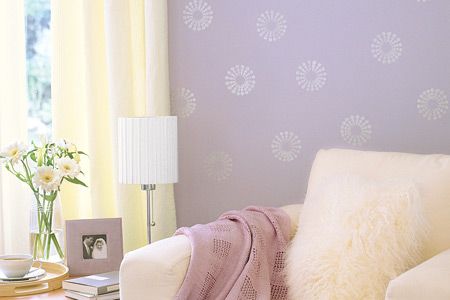Project details
Skill
Cost
Estimated Time
*Costs in this article sourced from Angi.
 Plate with a flat center
Plate with a flat center
Wall stamping allows you to create unique patterns and textures on your walls without the need for expensive wallpaper or complex painting techniques. With the right tools and a bit of patience, you can transform a plain wall into a stunning focal point in just one day.
In this guide, we’ll walk you through the process of stamping a custom wall pattern, from selecting your materials to maintaining your finished design.
What Is Wall Stamping?
Wall stamping is a decorative painting technique that uses a stamp or stencil to apply repeating patterns onto a wall surface. This method allows you to create intricate designs that mimic the look of wallpaper or high-end wall coverings at a fraction of the cost. You can complete this project using various materials, including rubber stamps, foam rollers, or even custom-made stamps. You can purchase stamps from craft stores or make them at home using simple tools and materials.
Benefits of Wall Stamping
There are several advantages to choosing wall stamping over other decorative wall treatments:
- Cost-effective: Compared to wallpaper or professional faux painting, wall stamping is an affordable option that fits well within most budgets.
- Customizable: You can create unique patterns by combining different stamps or colors, giving you complete control over the design.
- DIY-friendly: With some practice, most homeowners can achieve professional-looking results without needing specialized skills or equipment.
- Easy to change: Unlike wallpaper, stamped patterns can easily be painted over to update your decor, making them a flexible choice for ever-changing design preferences.
Essential Tools and Materials for Wall Stamping
To get started with wall stamping, you’ll need the right supplies. Before starting your painting project, we recommend considering the following:
Choosing the Right Stamp
The stamp you select will determine the overall look of your wall. Consider these options:
- Custom-made stamps for unique designs
- Foam rollers with patterns
- Pre-made rubber stamps
Selecting Appropriate Paint
Choose a paint that complements your base wall color and provides the desired effect:
- Acrylic craft paint for metallic or shimmery finishes
- Latex paint for a more traditional look
- Specialty paints for textured effects
Additional Supplies Needed
Gather these items to complete your wall stamping project:
- Drop cloths
- Level and measuring tape for precise alignment
- Mini paint roller
- Painter’s tape
- Pencil and string for marking guides
- Plate with a flat center for paint loading
- Practice paper or poster board
Preparing Your Wall for Stamping
Proper wall preparation ensures that your paint adheres well and that the final design is smooth and even.
Cleaning and Priming the Surface
Start by thoroughly cleaning your walls to remove any dust, dirt, or grease. A clean surface is essential for proper paint adhesion. If needed, apply a primer to create a smooth, even surface for stamping. This step is especially important if you are covering up a dark or bright color beneath your base coat.
Step-by-Step Instructions To Stamping Your Wall
Step 1: Gather Your Materials
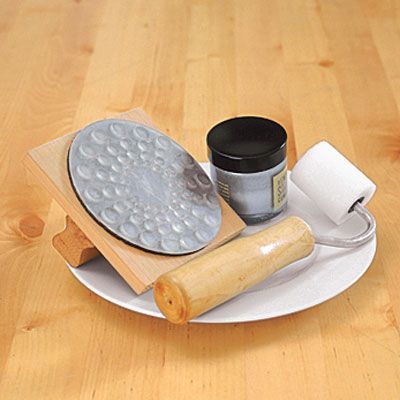
To get started, gather your stamp, acrylic craft paint, such as Folk-Art’s Metallic Silver, a dense foam mini roller, and a plate with a flat center.
Step 2: Prep the Roller
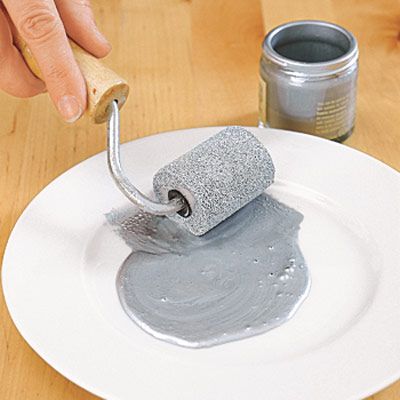
Pour paint on the plate and load the roller.
Step 3: Paint the Stamp
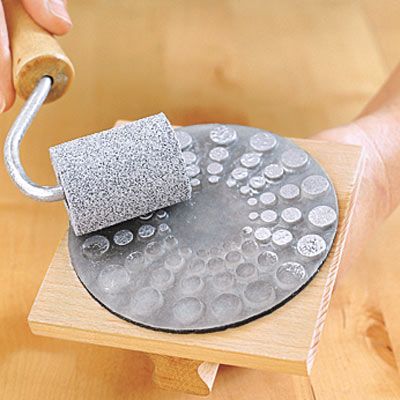
Roll on the paint evenly across the stamp. Before tackling the wall, practice on paper or poster board. “Tape it on the wall and practice stamping standing up,” says Jo Pearson, manager of creative services for Michaels Arts and Crafts. With its slightly curved base, the Funky Stamp calls for a firm rolling motion.
Step 4: Start Stamping
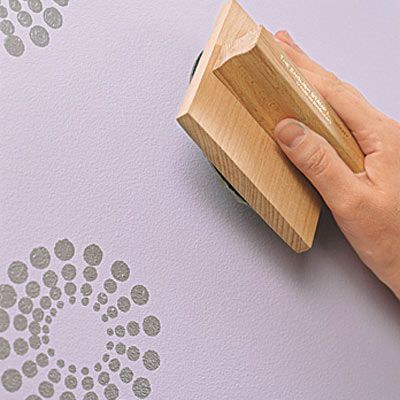
To avoid rigid rows while creating an evenly spaced pattern on the wall, tie a pencil to a string and knot the end; the one used for this design was about 12 inches from the pencil. Place the knot at the center of your first medallion, mark the next center with the pencil, and so on. Let the medallions bump up against windows, corners, and doors.
The payoff? “Stamping gives a room a personal look,” says Pearson. “And it’s a whole lot quicker than putting up wallpaper.”
Advanced Wall Stamping Techniques
Once you’ve mastered the basics, try these advanced techniques to create more complex designs. These methods can add depth and sophistication to your stamped walls.
Layering Multiple Stamps
Create depth and interest by using multiple stamps in different colors or sizes. Allow each layer to dry before applying the next to prevent smudging. This technique can create a multilayered effect that adds visual complexity to your wall.
Creating Ombre Effects
Gradually blend colors as you move across or down the wall for a subtle ombre effect. Mix your paint colors in small increments to achieve a smooth transition. This technique can add a gradient effect that makes your wall look dynamic and interesting.
Combining Techniques
Mix and match different techniques to create a unique look. For example, combine an ombre background with layered stamps for a custom design. Experimenting with different approaches can lead to stunning, one-of-a-kind results.
Maintaining Your Stamped Wall Pattern
Proper care will help your stamped wall pattern look great for years to come. Maintaining your design ensures its longevity and keeps it looking fresh.
Cleaning Tips
- Dust your walls regularly with a soft, dry cloth or duster. Regular dusting prevents buildup that can dull your pattern.
- For stubborn marks, use a damp cloth with mild soap, being careful not to scrub too hard. Gentle cleaning preserves the integrity of your stamped design.
Touch-Up Techniques
Keep some of your stamping paint on hand for touch-ups. Use a small brush to carefully reapply paint to any areas that may have chipped or faded over time. Regular touch-ups keep your pattern looking pristine.
Creative Wall Stamping Ideas and Inspirations
We recommend considering some of these wall stamping ideas for your next project.
Geometric Patterns
Create modern, eye-catching designs with triangles, hexagons, or chevron patterns. These work well in contemporary spaces and can add a sense of movement to your walls. Geometric patterns are bold and can serve as a striking focal point.
Nature-Inspired Designs
Bring the outdoors in with leaf, flower, or tree branch patterns. These organic shapes can create a calming atmosphere in bedrooms or living areas. Nature-inspired designs can add a touch of tranquility to any room.
Abstract Art
Experiment with abstract shapes and colors to create a unique, artistic wall. This approach allows for complete creative freedom and can result in a truly personalized design. Abstract art can make a powerful visual statement.
